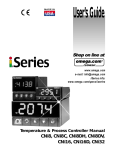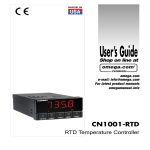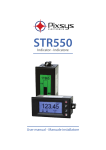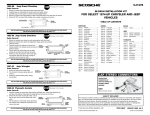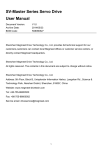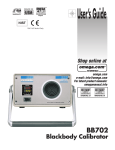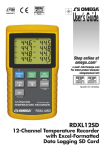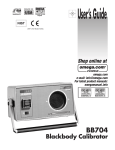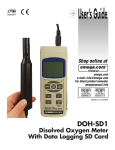Download Omega DP26-RTD User's Manual
Transcript
MADE IN USA User’s Guide Shop on line at omega.com e-mail: [email protected] For latest product manuals omegamanual.info DP26-RTD Differential Temperature Meter with RTD ® ® OMEGAnet® On-Line Service www.omega.com Internet e-mail [email protected] Servicing North America: USA:PP PP PP One Omega Drive, P.O. Box 4047 Stamford CT 06907-0047 TEL: (203) 359-1660PP FAX: (203) 359-7700 e-mail: [email protected] Canada:@ P PP PP PP 976 Bergar Laval (Quebec) H7L 5A1 TEL: (514) 856-6928PP e-mail: [email protected] ISO 9001 CertifiedP FAX: (514) 856-6886 For immediate technical or application assistance: USA and Canada:P PP PP Sales Service: 1-800-826-6342 / 1-800-TC-OMEGA® Customer Service: 1-800-622-2378 / 1-800-622-BEST® Engineering Service: 1-800-872-9436 / 1-800-USA-WHEN® Mexico and P Latin American:P PP TEL: (001)800-TC-OMEGA®P FAX: (001) 203-359-7807 En Español: (001) 203-359-7803P e-mail: [email protected] Servicing Europe: Czech Republic:P PP PP Frystatska 184, 733 01 Karviná TEL: +420 59 6311899PP e-mail: [email protected] Germany/Austria:P PP PP PP Daimlerstrasse 26, D-75392 Deckenpfronn, Germany TEL: +49 7056 9398-0PP FAX: +49 7056 9398-29 Toll Free in Germany: 0800 639 7678 e-mail: [email protected] United Kingdom:P ISO 9002 CertifiedP PP PP PP PP One Omega Drive River Bend Technology Centre Northbank, Irlam Manchester M44 5BD United Kingdom TEL: +44 161 777 6611P FAX: +44 161 777 6622 Toll Free in England: 0800 488 488 e-mail: [email protected] FAX: +420 59 6311114 It is the policy of OMEGA to comply with all worldwide safety and EMC/EMI regulations that apply. OMEGA is constantly pursuing certification of its products to the European New Approach Directives. OMEGA will add the CE mark to every appropriate device upon certification. The information contained in this document is believed to be correct, but OMEGA Engineering, Inc. accepts no liability for any errors it contains, and reserves the right to alter specifications without notice. WARNING: These products are not designed for use in, and should not be used for, patient-connected applications. ! This device is marked with the international caution symbol. It is important to read the Setup Guide before installing or commissioning this device as the guide contains important information relating to safety and EMC. PREFACE Manual Objectives This manual shows you how to set up and use the Differential RTD Meter. Standard Procedures: * Checking voltage jumpers, or changing voltage power * Mounting the panel * Selecting the input type * Selecting a decimal point position * Selecting reading configuration (Fahrenheit or Celsius) * Setting setpoint configuration * Setting setpoint deadbands * Entering temperature offset * Accessing the deviation mode * Selecting meter display Optional Procedures: * Enabling/disabling analog output * Selecting analog output as current or voltage * Selecting analog output or proportional control * Routing analog output * Selecting proportional band * Using manual reset (offsetting setpoint errors) * Scaling analog output For first-time users: Refer to the QuickStart Manual for basic operation and set-up instructions. i NOTES, WARNINGS and CAUTIONS Information that is especially important to note is identified by these labels: • • • • NOTE WARNING CAUTION IMPORTANT NOTE: provides you with information that is important to successfully setup and use the Programmable Digital Meter. CAUTION or WARNING: tells you about the risk of electric shock. CAUTION, WARNING or IMPORTANT: tells you of circumstances or practices that can effect the meter's functionality and must refer to accompanying documents. TIP: Provides you helpful hints. iii Table of Contents Section Page 1. INTRODUCTION . . . . . . . . . . . . . . . . . . . . . . . . . . . . . . . . . . . . . . . . . . . . . . .1 1.1 UNPACKING . . . . . . . . . . . . . . . . . . . . . . . . . . . . . . . . . . . . . . . . . . .1 1.2 SAFETY CONSIDERATIONS . . . . . . . . . . . . . . . . . . . . . . . . . . . . . . .2 2. ABOUT THE METER . . . . . . . . . . . . . . . . . . . . . . . . . . . . . . . . . . . . . . . . . . . .3 2.1 DESCRIPTION . . . . . . . . . . . . . . . . . . . . . . . . . . . . . . . . . . . . . . . . .3 2.2 STANDARD FEATURES . . . . . . . . . . . . . . . . . . . . . . . . . . . . . . . . . .3 2.3 AVAILABLE ACCESSORIES . . . . . . . . . . . . . . . . . . . . . . . . . . . . . . . .4 2.4 FRONT OF THE METER . . . . . . . . . . . . . . . . . . . . . . . . . . . . . . . . . .5 2.5 FRONT-PANEL BUTTON LOCK OUT . . . . . . . . . . . . . . . . . . . . . . . . .8 2.5.1 Push Button Lock Out . . . . . . . . . . . . . . . . . . . . . . . . . . . . . . . .8 2.5.2 Jumper Lock Out . . . . . . . . . . . . . . . . . . . . . . . . . . . . . . . . . . .8 2.6 BACK OF THE METER . . . . . . . . . . . . . . . . . . . . . . . . . . . . . . . . . . .9 2.7 DISASSEMBLY . . . . . . . . . . . . . . . . . . . . . . . . . . . . . . . . . . . . . . . .11 3. GETTING STARTED . . . . . . . . . . . . . . . . . . . . . . . . . . . . . . . . . . . . . . . . . . .12 3.1 RATING/PRODUCT LABEL . . . . . . . . . . . . . . . . . . . . . . . . . . . . . . .12 3.2 MAIN BOARD POWER JUMPERS . . . . . . . . . . . . . . . . . . . . . . . . . .12 3.3 MOUNTING THE METER . . . . . . . . . . . . . . . . . . . . . . . . . . . . . . . .15 3.4 CONNECTING SENSOR INPUT . . . . . . . . . . . . . . . . . . . . . . . . . . .16 3.5 CONNECTING MAIN POWER . . . . . . . . . . . . . . . . . . . . . . . . . . . . .17 3.6 CONNECTING ANALOG AND RELAY OUTPUT CONNECTIONS . .19 4. CONFIGURING THE METER . . . . . . . . . . . . . . . . . . . . . . . . . . . . . . . . . . . . .20 4.1 SELECTING THE INPUT TYPE (INPT) . . . . . . . . . . . . . . . . . . . . . .20 4.2 SELECTING DECIMAL POINT POSITION (DEC.P) . . . . . . . . . . . . .20 4.3 SELECTING READING CONFIGURATION ("RD.CF") . . . . . . . . . . .21 4.4 SETTING SETPOINT 1 CONFIGURATION (S1.CF) . . . . . . . . . . . . .22 4.5 SETTING SETPOINT 2 CONFIGURATION (S2.CF) . . . . . . . . . . . . .23 4.6 SETTING SETPOINT 1 DEADBAND (S1.DB) . . . . . . . . . . . . . . . . . .24 4.7 SETTING SETPOINT 2 DEADBAND (S2.DB) . . . . . . . . . . . . . . . . . .25 iv Section Page 4.8 SELECTING OUTPUT CONFIGURATION (OT.CF) . . . . . . . . . . . . . .26 4.8.1 Enabling or Disabling The Analog Output . . . . . . . . . . . . . . . . .26 4.8.2 Selecting Analog Output as Current or Voltage . . . . . . . . . . . .27 4.8.3 Selecting Analog Output or Proportional Control . . . . . . . . . . .27 4.9 ROUTING ANALOG OUTPUT (OUT) . . . . . . . . . . . . . . . . . . . . . . . .29 4.10 SELECTING PROPORTIONAL BAND (P.BND) . . . . . . . . . . . . . . . .29 4.11 USING MANUAL RESET (M.RST) . . . . . . . . . . . . . . . . . . . . . . . . .31 4.12 SCALING THE ANALOG OUTPUT (OT.S.O) . . . . . . . . . . . . . . . . .32 4.13 RTD TEMPERATURE OFFSET ERROR CORRECTION . . . . . . . .36 5. ACCESSING THE DEVIATION MODE . . . . . . . . . . . . . . . . . . . . . . . . . . . . . .38 6. SELECTING METER DISPLAY . . . . . . . . . . . . . . . . . . . . . . . . . . . . . . . . . . . .39 7. TUNING THE PROPORTIONAL CONTROLLER . . . . . . . . . . . . . . . . . . . . . . .41 8. DISPLAY MESSAGES . . . . . . . . . . . . . . . . . . . . . . . . . . . . . . . . . . . . . . . . . .42 9. MENU CONFIGURATION . . . . . . . . . . . . . . . . . . . . . . . . . . . . . . . . . . . . . . . .43 10. FRONT PANEL DISPLAYS . . . . . . . . . . . . . . . . . . . . . . . . . . . . . . . . . . . . . . 45 11. SETPOINT CONFIGURATION DISPLAYS 12. SPECIFICATIONS . . . . . . . . . . . . . . . . . . . . . . . . . .48 . . . . . . . . . . . . . . . . . . . . . . . . . . . . . . . . . . . . . . . . . . . .49 13. FACTORY PRESET VALUES . . . . . . . . . . . . . . . . . . . . . . . . . . . . . . . . . . . .53 14. CE APPROVALS . . . . . . . . . . . . . . . . . . . . . . . . . . . . . . . . . . . . . . . . . . . . .54 v List of Figures Figure Figure Figure Figure Figure Figure Figure Figure Figure Figure Figure Figure Figure Figure Figure Figure Figure Figure 2-1. Front-Panel . . . . . . . . . . . . . . . . . . . . . . . . . . . . . . . . . . . . . . . . . . . .5 2-3. Connector Label (AC-Powered and DC-Powered Detail) . . . . . . . . . . .9 3-1. Main Board Power Jumpers (W1, W2, W3) . . . . . . . . . . . . . . . . . . . .12 3-2. Main Board Jumper Positions . . . . . . . . . . . . . . . . . . . . . . . . . . . . . .13 3-3. Upper Option Board Installation . . . . . . . . . . . . . . . . . . . . . . . . . . . .13 3-4. Meter - Exploded View . . . . . . . . . . . . . . . . . . . . . . . . . . . . . . . . . . .15 3-5. Panel Cut-Out . . . . . . . . . . . . . . . . . . . . . . . . . . . . . . . . . . . . . . . . . .15 3-6. 2-Wire RTD Input Connection . . . . . . . . . . . . . . . . . . . . . . . . . . . . . .16 3-7. 3-Wire RTD Input Connection . . . . . . . . . . . . . . . . . . . . . . . . . . . . . .16 3-8. 4-Wire RTD Input connection . . . . . . . . . . . . . . . . . . . . . . . . . . . . . .16 3-9. Main Power Connections - AC Powered Unit . . . . . . . . . . . . . . . . . . .17 3-10. Main Power Connections - DC Powered Unit . . . . . . . . . . . . . . . . . .18 3-11. Relay Output Connections . . . . . . . . . . . . . . . . . . . . . . . . . . . . . . .18 3-12. Analog Output Connections. . . . . . . . . . . . . . . . . . . . . . . . . . . . . . .19 3-13. Isolated Analog Output Connections. . . . . . . . . . . . . . . . . . . . . . . . .19 4-1 Proportional Band . . . . . . . . . . . . . . . . . . . . . . . . . . . . . . . . . . . . . . .29 12-1. Meter Dimensions . . . . . . . . . . . . . . . . . . . . . . . . . . . . . . . . . . . . . .53 List of Tables Table Table A-1. Sections of the Manual . . . . . . . . . . . . . . . . . . . . . . . . . . . . . . . . . . . . .ii Table 2-1. Accessories and Add-Ons . . . . . . . . . . . . . . . . . . . . . . . . . . . . . . . . . .4 Table 2-2. Connector Description . . . . . . . . . . . . . . . . . . . . . . . . . . . . . . . . . . . .10 Table 3-1. S3 Jumper Functions . . . . . . . . . . . . . . . . . . . . . . . . . . . . . . . . . . . . .14 Table 3-2. Main Power Connections - AC Powered Unit . . . . . . . . . . . . . . . . . . . .18 Table 6-1. Truth Table for Display Values . . . . . . . . . . . . . . . . . . . . . . . . . . . . . .39 Table 8-1. Display Messages . . . . . . . . . . . . . . . . . . . . . . . . . . . . . . . . . . . . . . .42 Table 9-1. Configuration Menu . . . . . . . . . . . . . . . . . . . . . . . . . . . . . . . . . . . . . .43 Table 10-1. Front Panel Displays . . . . . . . . . . . . . . . . . . . . . . . . . . . . . . . . . . . .45 Table 10-2 Run Mode Displays . . . . . . . . . . . . . . . . . . . . . . . . . . . . . . . . . . . . . .48 Table 11-1. Setpoint Configuration Displays . . . . . . . . . . . . . . . . . . . . . . . . . . . .49 Table 13-1. Factory Preset Values . . . . . . . . . . . . . . . . . . . . . . . . . . . . . . . . . . .54 vi SECTION 1. INTRODUCTION 1.1 UNPACKING Remove the Packing List and verify that all equipment has been received. If there are any questions about the shipment, use the phone numbers listed on the back cover to contact the Customer Service Department nearest you. Upon receipt of shipment, inspect the container and equipment for any signs of damage. Take particular note of any evidence of rough handling in transit. Immediately report any damage to the shipping agent. The carrier will not honor any claims unless all shipping material is saved for their examination. After examining and removing contents, save packing material and carton in the event reshipment is necessary. Verify that you receive the following items in the shipping box: QTY DESCRIPTION 1 Meter with all applicable connectors attached. 1 Owner's Manual 1 Set Mounting brackets 1 QuickStart Manual If you ordered any of the available options (except the "BL" Blank Lens option), they will be shipped in a separate container to avoid any damage to your indicator/controller. 1 SECTION 1.2 SAFETY CONSIDERATIONS This device is marked with the international caution symbol. It is important to read this manual before installing or commissioning this device as it contains important information relating to Safety and EMC (Electromagnetic Compatibility). This instrument is a panel mount device protected in accordance with EN 61010-1:2001, electrical safety requirements for electrical equipment for measurement, control and laboratory. Installation of this instrument should be done by qualified personnel. In order to ensure safe operation, the following instructions should be followed. This instrument has no power-on switch. An external switch or circuit-breaker shall be included in the building installation as a disconnecting device. It shall be marked to indicate this function, and it shall be in close proximity to the equipment within easy reach of the operator. The switch or circuit-breaker shall not interrupt the Protective Conductor (Earth wire), and it shall meet the relevant requirements of IEC 947–1 and IEC 947-3 (International Electrotechnical Commission). The switch shall not be incorporated in the main supply cord. Furthermore, to provide protection against excessive energy being drawn from the main supply in case of a fault in the equipment, an overcurrent protection device shall be installed. • Do not exceed voltage rating on the label located on the top of the instrument housing. • Always disconnect power before changing signal and power connections. • Do not use this instrument on a work bench without its case for safety reasons. • Do not operate this instrument in flammable or explosive atmospheres. • Do not expose this instrument to rain or moisture. • Unit mounting should allow for adequate ventilation to ensure instrument does not exceed operating temperature rating. • Use electrical wires with adequate size to handle mechanical strain and power requirements. Install without exposing bare wire outside the connector to minimize electrical shock hazards. EMC Considerations • Whenever EMC is an issue, always use shielded cables. • Never run signal and power wires in the same conduit. • Use signal wire connections with twisted-pair cables. • Install Ferrite Bead(s) on signal wires close to the instrument if EMC problems persist. Note ☞ Failure to follow all instructions and warnings may result in injury! 2 SECTION 2. ABOUT THE METER 2.1 DESCRIPTION The Differential RTD meter is a value packed indicator/controller. Four full digits accurately display your temperature. Select from DIN (Alpha = .00385) or NIST (Alpha = .00392); 2,3, or 4 wire RTD. Your meter may be a basic indicator or it may include analog output or dual relay output. Analog or dual relay output must be ordered at time of purchase. Analog output is fully scalable and may be configured as a proportional controller, or to follow your display. Dual 5 amp, form C relays control critical processes. Front panel peak detection and memory is also standard. A mechanical lockout has been included to guard against unauthorized changes. 2.2 STANDARD FEATURES The following is a list of features: * * * * * * * 4-digit, 14 segment LED Display NEMA 4/Type 4 Front Bezel ±0.5° C accuracy Automatic Decimal Adjustment Non-volatile memory 115 or 230 V ac 50/60 Hz power supply or 10-32 Vdc or 26-56 Vdc T1, T2, T1-T2 display The following is a list of optional features * * * * * * Dual 5 amps, form C relay outputs Scalable analog output Analog out Proportional control Easy setup for proportional control Front-panel deviation correction Easy RTD error offset calibration 3 2.3 AVAILABLE ACCESSORIES Table 2.1 Accessories and Add-ons Add-On Options FS SPC4 SPC18 Special Calibration/Configuration NEMA-4 Splash Proof Cover NEMA-4 Splash Proof Cover, NEW Accessories TP1A RP18 RP28 RP38 Trimplate panel adaptor. Adapts DIN1A/DIN2A cases to larger panel cutouts 19-In. Rack Panel for one (1) 1/8 DIN instrument 19-In. Rack Panel for two (2) 1/8 DIN instrument 19-In. Rack Panel for three (3) 1/8 DIN instrument 4 2.4 FRONT OF THE METER Figure 5-1 shows the location of each part of the front of the meter. •••• T1 1 SETPTS /T1/T2/ - T2 /DEV C F 2 MENU RESET Figure 2-1 Front Panel Digital LED Display: -1.9.9.9. or 9.9.9.9. 4-digit, 14 segment, 13.8 mm (0.54") high LED display with programmable decimal point. These meter display windows light when appropriate: 1 2 C F T1 T2 T1-T2 - Setpoint 1 status Setpoint 2 status °C unit indicator °F unit indicator T1 on display T2 on display T1-T2 on display 5 Pushbuttons for programming the meter. 5 2.4 FRONT OF THE METER (Continued) METER BUTTONS SETPTS Button In the run mode, press this button to sequentially recall the previous setpoint settings. After using the /T1/T2 and /DEV buttons to alter these settings as desired, press the SETPTS button to store these new values. Unless you press the SETPTS, /T1/T2 or /DEV button within 20 seconds to store your input, the meter will scroll to setpoint 2 the return to the run mode. If the dual relay option is not installed or if the “L.3=1” on the “LK.CF” menu, pressing the SETPTS button will display the meter's firmware version. /T1/T2 Button In the run mode, pressing the /T1/T2 button will scroll to show T1, T2, and T1-T2. During the configuration mode or Setpoint modes, use the /T1/T2 button to change the values of the flashing digit shown on the display and/or toggle between menu choices, such as "R.1=F" or "R.1=C". When configuring your setpoint values, press the /T1/T2 button to increment the flashing digit from 0 to 9 by 1's. /DEV Button In the run mode press the /DEV button to display the deviation of reading from Setpoint 1. In the configuration or setpoint modes, press the /DEV button to scroll to the next digit. 6 2.4 FRONT OF THE METER (Continued) MENU Button In the run mode, press the MENU button to terminate the current measuring process and enter you into the configuration mode. In the configuration mode, press the MENU button to store changes in the non-volatile memory and then advance you to the next menu item. To lock the MENU button, install S3E jumper. Refer to Table 3-1 for more information about the S3 jumpers. RESET Button In the run mode, press the RESET button to: * reset the latched setpoints. The display will show "SP.RS" (Setpoint Reset). * perform tuning for Proportional Control if the meter is setup to serve as a proportional controller (0.3=P refer to Section 4.8.3 and Section 7) the meter will show “TUNE”. Also in the run mode, if you hard reset or power off/on the meter, it shows "RST" followed by "D.RTD". In the configuration mode, press the RESET button once to review the previous menu. Pressing the RESET button twice results in a hard reset and returns you to the run mode. In the setpoint mode, press RESET button to go back to the run mode. THe meter will show “RUN”. 7 2.5 FRONT PANEL LOCKOUT 2.5.1 PUSH BUTTON LOCKOUT To lock the RESET, MENU and SETPTS buttons, verify that the S3-A jumper is installed and the S3-E jumper is not installed, then follow these steps: In the run mode1. Press and hold down the RESET button. The meter shows “SP.RS”. Do not release the RESET button. 2. Press the MENU button and hold RESET button down (3-5 seconds) until the meter shows “LOCK”. 3. Release both buttons. To unlock the RESET, MENU and SETPTS buttons, follow these steps: 1. Press and hold down the RESET button. The meter shows “LOCK”. Do not release the RESET button. 2. Press the MENU button and hold RESET button down (3-5 seconds) until the meter shows “UN.LK”. 3. Release both buttons. 2.5.2 JUMPER LOCKOUT To lock all front panel buttons, remove the S3-A jumper (refer to Figure 3-2). To lock the MENU button only, verify that the S3-B jumper is removed, then install the S3-A and S3-E jumpers, (refer to Table 3-1). 8 2.6 BACK OF THE METER Figure 2-2 shows the connector label mounted at the top of the meter housing. Table 2-2 gives a brief description of each connector at the back of the meter. POWER & INPUT CONNECTIONS (DIFFERENTIAL RTD) RTD2 +E2 +S2 +E1 -S2 +S1 -E2 -S1 -E1 RTD1 Figure 2-2 Connector label (ac Powered and dc Powered detail) 9 2.6 BACK OF THE METER (Continued) Table 2-2 Connector Description Connector TB1-1 TB1-2 TB1-3 TB1-4 TB1-5 TB1-6 TB1-7 TB1-8 TB1-9 TB1-10 TB1-11 TB1-12 TB2-1 TB2-2 TB2-3 TB2-4 TB2-5 TB2-6 TB2-7 TB2-8 TB5-1 TB5-2 TB5-3 Description Setpoint 1: Normally open (N.O.1) connection Setpoint 1: Normally closed (N.C.1) connection Setpoint 1: Common (COM1) connection Setpoint 2: Normally open (N.O.2) connection Setpoint 2: Normally closed (N.C.2) connection Setpoint 2: Common (COM2) connection ac line connection (no connections on dc-powered units) ac neutral connection (+ Input on dc-powered units) ac Earth ground (-dc-power return on dc-powered units) Analog 1 voltage output Analog 2 current output Analog 3 return +E2: Positive excitation for input #2 +S2: Positive signal input for input #2 -S2: Negative signal input for input #2 -E2: Negative excitation for input #2 +E1: Positive excitation for input #1 +S1: Positive signal input for input #1 -S1: Negative signal input for input #1 -E1: Negative excitation for input #1 Isolated Analog Voltage Output Isolated Analog Current Output Isolated Analog Output Return 10 2.7 DISASSEMBLY You may need to open up the meter for one of the following reasons: • To check or change the 115 or 230 Vac power jumpers. • To install or remove jumpers on the main board. Disconnect the power supply before proceeding. To remove and access the main board, follow these steps: • Disconnect the main power from the meter. • Remove the back case cover. • Lift the back of the main board upwards and let it slide out of the case. 11 SECTION 3. GETTING STARTED Caution: The meter has no power-on switch, so it will be in operation as soon you apply power. If you power off/on the meter, or perform a hard reset (press the RESET button twice), the meter shows "RST", followed by "D.RTD". 3.1 RATING/PRODUCT LABEL This label is located on top of the meter housing (Refer to Figure 3-3). 3.2 MAIN BOARD POWER JUMPERS Important: If you want to change the Factory preset jumpers, do the following steps; otherwise go to section 3.3. Warning: Disconnect the power from the unit before proceeding. This device must only be reconfigured by a specially trained electrician with corresponding qualifications. Failure to follow all instructions and warnings may result in injury! To check voltage jumpers, or to change from 115 V to 230 V ac: 1. Remove the main board from the case. Refer to Section 2.7. 2. Locate the solder jumpers W1, W2, and W3 (located near the edge of the main board alongside the transformer - refer to Figure 3-1). 3. If your power requirement is 115 V ac, solder jumpers W1 and W3 should be wired, but jumper W2 should not. If your power requirement is 230 V ac, solder jumper W2 should be wired, but jumpers W1 and W3 should not. Figure 3-1 shows the location of solder jumpers W1 through W3 on the main board. Figure 3.1 Main Board Power Jumpers 12 3.2 MAIN BOARD POWER JUMPERS (Continued) Figure 3-2 shows the main board jumpers. Figure 3.2 Main Board Jumper Positions Attach cable to P1. TB5 P1 Figure 3.3 Upper Option Board Installation 13 3.2 MAIN BOARD POWER JUMPERS (Continued) S2 jumpers are for sensor break indications: * * * * S2A jumper is not used S2B jumper is for positive sensor break on input 1 (i.e. heating) S2C jumper is for positive sensor break on input 2 (i.e. heating) S2D is not used S3 jumpers are used for the following (refer to Table 3-1): * * * * To enable or disable the front panel push-buttons To allow for an extremely low resistance load for analog output To disable the MENU button To perform calibration procedure Test pins TP1 - TP11 are for testing purposes. Do not use as reading errors may result. Table 3-1 S3 Jumper Functions Jumper S3-A S3-B S3-C S3-D S3-E Description Install to enable front panel push-buttons. Remove to disable all front panel push-buttons Removed. Install for factory calibration only. Normally removed. Install for analog voltage output when load is less than 1 Kohm impedance. Care should be taken when installing this jumper. Removed. Not used. If installed without S3-B, the MENU button locks out. While in run mode, if you press the MENU button, the display shows “LOCK". 14 3.3 MOUNTING THE METER RE A (R R C EM OV OV ER ED CONNECTOR ) PANEL CUT-OUT "NEW" STYLE MOUNTING BRACKET LABEL PRODUCT LABEL CASE "OLDER" STYLE MOUNTING BRACKET 2 PCS GASKET FRONT BEZEL Figure 3-3 Meter - Exploded View 1. Cut a hole in your panel, as shown in Figure 3-3. For specific dimensions refer to Figure 3-4. 2. Insert the meter into the hole. Be sure the front bezel gasket is flush to the panel. 3. Slide on mounting bracket to secure. 4. Proceed to Section 3.4 to connect your sensor input and main power. PANEL THICKNESS 6,4 (.25) MAX 0,8 (.03) MIN 1,5 R(.06) 4 PLCS 45,00 + 0,61/-0,00 (1.772 + .024/–.000) 92,00 + 0,81/–0,00 (3.622 + .032/–.000) NOTE: Dimensions in Millimeters (Inches) Figure 3-4 Panel Cut-Out 15 3.4 CONNECTING SENSOR INPUT Figure 3-5 through 3-7 illustrate how to connect you power sensors. +E2 +S2 1 -S2 -E2 2 3 5 6 +E1 +S1 4 7 8 -S1 -E1 RTD Channel 2 RTD Channel 1 Figure 3-5 2-Wire RTD Input Connection -S2 -E2 +E2 +S2 1 2 3 5 6 +E1 +S1 4 7 RTD Channel 2 8 -S1 -E1 RTD Channel 1 Figure 3-6 3-Wire RTD Input Connection -S2 -E2 +E2 +S2 1 2 5 +E1 +S1 3 6 4 7 RTD Channel 2 8 -S1 -E1 RTD Channel 1 Figure 3-7 4-Wire RTD Input Connection Note: Install rear plastic cover after RTD connection. 16 3.5 CONNECTING MAIN POWER Connect the ac main power connections as shown in Figure 3-8. Warning: Do not connect AC power to your device until you have completed all input and output connections. This device must only be installed by a specially trained electrician with corresponding qualifications. Failure to follow all instructions and warnings may result in injury! Figure 3-8 Main Power Connections (ac powered unit) Table 3-2 shows the wire color and respective terminal connections for both USA and Europe. Table 3-2 Main Power Connections (ac powered unit) WIRE COLORS TB1 AC POWER EUROPE USA 7 ~ ac Line Brown Black 8 ~ ac Neutral Blue White 9 ~ ac Earth Green/Yellow Green 17 3.5 CONNECTING MAIN POWER (Continued) Connect the dc main power connections as shown in Figure 3-9.. Figure 3-9 Main Power Connections (dc powered unit) 3.6 ANALOG AND RELAY OUTPUT CONNECTIONS If you have purchased a meter with analog or dual relay or isolated analog output, refer to the following figures for output connections. Figure 3-10 Relay Output Connections 18 3.6 ANALOG AND RELAY OUTPUT CONNECTIONS (continued) Figure 3-11 Analog Output Connections Figure 3-12 Isolated Analog Output Connections 19 Table 10-1 Front-Panel Displays (continued) MENU /DEV /T1/T2/ DESCRIPTION P.BND Scroll right one digit Changes the value of the flashing digit Proportional Band select from 0000 through 9999 M.RST Scroll right one digit Changes the value of the flashing digit Manual Reset select from 0000 through 9999 T1.OF Shows prior value entered. Scroll right one digit Changes the value of the flashing digit RTD Temperature Offset Channel 1 T2.OF Shows prior value entered. Scroll right one digit Changes the value of the flashing digit RTD Temperature Offset Channel 2 Table 10-2 Run Mode Display DISPLAY /DEV /T1/T2/ Run Mode RESET DESCRIPTION LATCHED RESET Press RESET button to reset your setpoints. 47 SECTION 11. SETPOINT CONFIGURATION DISPLAYS Table 11-1 Setpoints Configuration Displays MENU SP 1 Setpoint 1 SP 2 Setpoint 2 /DEV /T1/T2/ DESCRIPTION Press to scroll to the next digitto the right Press to change the value of the flashing digit SETPOINT 1 Scroll right one digit Press to change the value of the flashing digit SETPOINT 2 48 Select from -1999 through 9999 Select from -1999 through 9999 SECTION 12. SPECIFICATIONS SIGNAL INPUT RTD types: DIN (0.00385) type 2,3, or 4 wire NIST (0.00392) type 2,3, or 4 wire Lead Resistance for Specified Accuracy: 2 Wire Up to 55 milliohm/lead 3 Wire Up to 10 ohms/lead balanced 4 Wire Up to 20 ohms/total unbalanced Isolation: Dielectric strength to 2500V transient per 3mm spacing based on EN 61010 for 260Vrms or dc working voltage Noise Rejection: Normal Mode Rejection (NMR) = 60dB Common Mode Rejection (CMR) = 120dB Protection: 240 V rms max for voltage input ranges 200 mA for current input ranges Standard Display: 4-digit, 14-segment LED, 13.8 mm (0.54”) Symbol: ( -1.9.9.9. ~ 9.9.9.9.) ANALOG TO DIGITAL Technique: Dual slope Internal resolution: 15 bits Read rate: 3/seconds for each channel Polarity: Automatic ACCURACY AT 25°C Accuracy: ±0.50°C after 30 minute warm-up Temperature Stability: 0.04°C/°C Step response: 1 second to 99% of the final value 49 INPUT POWER INFORMATION: ~ AC units 115/230 V~(AC) ±10%, 50/60 Hz 7 W max, power consumption (Non-Isolated Analog Output) 8 W max, power consumption (Isolated Analog Output) DC units 10-32 Vdc 6 W max, power consumption (Non-Isolated Analog Output) 7 W max, power consumption (Isolated Analog Output) External Fuse Required: IEC 127-2/III Power Fuse 115 V 125 mA @ 250 (T) 230 V 63 mA @ 250 (T) UL 248-14 (Listed Fuse) Power Fuse 115 V 175 mA @ 250 V Slow-Blow 230 V 80 mA @ 250 V Slow-Blow ENVIRONMENT Operating temperature: 0 to 50°C (32° to 122°F) Storage temperature: -40° to 85°C (-40° to 185°F) Relative humidity: 90% at 40°C (non-condensing) MECHANICAL Panel cutout: 1/8 DIN 3.62 x 1.78" (92 x 45 mm) Weight: 1.27 lb (574 g) Case material: Polycarbonate, 94 V-O UL rated 50 ANALOG OUTPUT (if applicable) Signal type: Current or voltage Signal level: Current: 10 V max compliance at 20 mA output Voltage: 20 mA max for 0-10 V output Function: May be assigned to a display range or proportional control output with setpoint #1 when used as a control output. Linearity: 0.2% Load Regulation: 1.1% Line Regulation: Step Response Time: 0.02% /V ac 2 - 3 seconds to 99% of the final value ALARM OUTPUTS (if applicable) 2 Form "C" on/off relays. Configurable for latched and unlatched by software. Max current: 5 AMPS, resistive load. Max voltage: 250 V ac or 30 V dc ISOLATED ANALOG OUTPUT (TB5, if applicable) Same as non-isolated analog output except isolated to 1000 Vdc. Signal Type: Current or voltage Signal Level: Current: 10 V max compliance at 20 mA output Voltage: 20 mA max for 0-10 V output Function: May be assigned to a display range or proportional control output with setpoint #1 when used as a control output. Linearity: 0.2% Step Response Time: 2 - 3 seconds to 99% of the final value Only one analog output is available on each unit and it must be factory installed. 51 48,0 (1.89) 96,0 (3.78) FRONT BEZEL 20,3 (.80) 151,4 (5.96) RETAINER CASE REAR COVER TOP VIEW SIDE VIEW PANEL THICKNESS 6,4 (.25) MAX 0,8 (.03) MIN 1,5 R(.06) 4 PLCS 45,00 + 0,61/-0,00 (1.772 + .024/–.000) 92,00 + 0,81/–0,00 (3.622 + .032/–.000) NOTE: Dimensions in Millimeters (Inches) Figure 12-1 Meter Dimensions 52 SECTION 13. FACTORY PRESET VALUES Table 13-1 Factory Preset Values MENU ITEM INPT DEC.P RD.CF S1.CF S2.CF S1.DB S2.DB OT.CF OUT OT.S.O T1.OF T2.OF SP1 SP2 FACTORY PRESET VALUES Input Type: 385.3 (3 wire DIN RTD) Decimal Point Position: FFF.F Reading Configuration: R.1=F (Fahrenheit) Setpoint 1 Configuration: S.1=A (Setpoint is active above) S.2=U (Setpoint is unlatched) S.3=0 (Setpoint 1 is assigned to T1-T2) Setpoint 2 Configuration: S.1=A (Setpoint is active above) S.2=U (Setpoint is unlatched) S.3=0 (Setpoint 2 is assigned to T1-T2) Setpoint 1 Deadband: .0003 Setpoint 2 Deadband: .0003 Output Configuration: O.1=E (Analog output is enabled) O.2=C (Analog output is current) O.3=A (Analog output follows the display value) Analog Output Routing: T1 - T2 Output Scale and Offset: 0-1000 = 4-20 mA dc RTD for T1: 000.0 RTD for T2: 000.0 Setpoint 1 Value: 000.0 Setpoint 2 Value: 000.0 53 CE APPROVALS INFORMATION This product conforms to the EMC directive 89/336/EEC amended by 93/68/EEC, and with the European Low Voltage Directive 72/23/EEC. Electrical Safety EN61010-1:2001 Safety requirements for electrical equipment for measurement, control and laboratory. Double Insulation Pollution Degree 2 Dielectric withstand Test per 1 min • Power to Input/Output: 2300 Vac (3250 Vdc) • Power to Input/Output: 500 Vac (720 Vdc) (Low Voltage dc Power Option*) • Power to Relays Output: 2300 Vac (3250 Vdc) • Relay 1 to Relay 2: 2300 Vac (3250 Vdc) • Isolated Analog to Inputs: 1000 Vac (1420 Vdc) • Analog to Inputs: No Isolation Measurement Category I Category I are measurements performed on circuits not directly connected to the Mains Supply (power). Maximum Line-to-Neutral working voltage is 50 Vac/dc. This unit should not be used in Measurement Categories II, III, IV. Transients Overvoltage Surge (1.2 / 50uS pulse) • Input Power: 2500 V • Input Power: 500 V (Low Voltage dc Power Option*) • Isolated Analog: 500 V • Input/Output Signals: 500 V Note: *Units configured for external low power dc voltage, 10-32 Vdc (Basic Insulation) EMC EN61326:1997 + and A1:1998 + A2:2001 Immunity and Emissions requirements for electrical equipment for measurement, control and laboratory. • EMC Emissions Table 4, Class B of EN61326 • EMC Immunity** Table 1 of EN61326 Note: **I/O signal and control lines require shielded cables and these cables must be located on conductive cable trays or in conduits. Furthermore, the length of these cables should not exceed 30 meters Refer to the EMC and Safety installation considerations (Guidelines) of this manual for additional information. 54 WARRANTY/DISCLAIMER OMEGA ENGINEERING, INC. warrants this unit to be free of defects in materials and workmanship for a period of one (1) year from the date of purchase. In addition to OMEGA’s standard warranty period, OMEGA Engineering will extend the warranty period for four (4) additional years if the warranty card enclosed with each instrument is returned to OMEGA. If the unit malfunctions, it must be returned to the factory for evaluation. OMEGA’s Customer Service Department will issue an Authorized Return (AR) number immediately upon phone or written request. Upon examination by OMEGA, if the unit is found to be defective, it will be repaired or replaced at no charge. OMEGA’s WARRANTY does not apply to defects resulting from any action of the purchaser, including but not limited to mishandling, improper interfacing, operation outside of design limits, improper repair, or unauthorized modification. This WARRANTY is VOID if the unit shows evidence of having been tampered with or shows evidence of having been damaged as a result of excessive corrosion; or current, heat, moisture or vibration; improper specification; misapplication; misuse or other operating conditions outside of OMEGA’s control. Components which wear are not warranted, including but not limited to contact points, fuses, and triacs. OMEGA is pleased to offer suggestions on the use of its various products. However, OMEGA neither assumes responsibility for any omissions or errors nor assumes liability for any damages that result from the use of its products in accordance with information provided by OMEGA, either verbal or written. OMEGA warrants only that the parts manufactured by it will be as specified and free of defects. OMEGA MAKES NO OTHER WARRANTIES OR REPRESENTATIONS OF ANY KIND WHATSOEVER, EXPRESS OR IMPLIED, EXCEPT THAT OF TITLE, AND ALL IMPLIED WARRANTIES INCLUDING ANY WARRANTY OF MERCHANTABILITY AND FITNESS FOR A PARTICULAR PURPOSE ARE HEREBY DISCLAIMED. LIMITATION OF LIABILITY: The remedies of purchaser set forth herein are exclusive, and the total liability of OMEGA with respect to this order, whether based on contract, warranty, negligence, indemnification, strict liability or otherwise, shall not exceed the purchase price of the component upon which liability is based. In no event shall OMEGA be liable for consequential, incidental or special damages. CONDITIONS: Equipment sold by OMEGA is not intended to be used, nor shall it be used: (1) as a “Basic Component” under 10 CFR 21 (NRC), used in or with any nuclear installation or activity; or (2) in medical applications or used on humans. Should any Product(s) be used in or with any nuclear installation or activity, medical application, used on humans, or misused in any way, OMEGA assumes no responsibility as set forth in our basic WARRANTY/DISCLAIMER language, and, additionally, purchaser will indemnify OMEGA and hold OMEGA harmless from any liability or damage whatsoever arising out of the use of the Product(s) in such a manner. RETURN REQUESTS/INQUIRIES Direct all warranty and repair requests/inquiries to the OMEGA Customer Service Department. BEFORE RETURNING ANY PRODUCT(S) TO OMEGA, PURCHASER MUST OBTAIN AN AUTHORIZED RETURN ( A R ) N U M B E R F R O M O M E G A’ S C U S TO M E R S E RV I C E D E PA RT M E N T ( I N O R D E R TO AV O I D PROCESSING DELAYS). The assigned AR number should then be marked on the outside of the return package and on any correspondence. The purchaser is responsible for shipping charges, freight, insurance and proper packaging to prevent breakage in transit. FOR WARRANTY RETURNS, please have the following information available BEFORE contacting OMEGA: 1. Purchase Order number under which the product was PURCHASED, 2. Model and serial number of the product under warranty, and 3. Repair instructions and/or specific problems relative to the product. FOR NON-WARRANTY REPAIRS, consult OMEGA for current repair charges. Have the following information available BEFORE contacting OMEGA: 1. Purchase Order number to cover the COST of the repair, 2. Model and serial number of product, and 3. Repair instructions and/or specific problems relative to the product. OMEGA’s policy is to make running changes, not model changes, whenever an improvement is possible. This affords our customers the latest in technology and engineering. OMEGA is a registered trademark of OMEGA ENGINEERING, INC. © Copyright 2006 OMEGA ENGINEERING, INC. All rights reserved. This document may not be copied, photocopied, reproduced, translated, or reduced to any electronic medium or machine-readable form, in whole or in part, without the prior written consent of OMEGA ENGINEERING, INC. PATENT NOTICE: This product is covered by one or more of the following patents: U.S. Pat. No. Des. 336,895; 5,274,577; 6,243,021 / CANADA 2052599; 2052600 / ITALY 1249456; 1250938 / FRANCE BREVET No. 91 12756 / SPAIN 2039150; 2048066 / UK PATENT No. GB2 249 837; GB2 248 954 / GERMANY DE 41 34398 C2. USED UNDER LICENSE. Other US and International Patents pending or applied for. Where Do I Find Everything I Need for Process Measurement and Control? OMEGA…Of Course! Shop on line at www.omega.com TEMPERATURE Thermocouple, RTD & Thermistor Probes, Connectors, Panels & Assemblies Wire: Thermocouple, RTD & Thermistor Calibrators & Ice Point References Recorders, Controllers & Process Monitors Infrared Pyrometers PRESSURE, STRAIN AND FORCE Transducers & Strain Gauges Load Cells & Pressure Gauges Displacement Transducers Instrumentation & Accessories FLOW/LEVEL Rotameters, Gas Mass Flowmeters & Flow Computers Air Velocity Indicators Turbine/Paddlewheel Systems Totalizers & Batch Controllers pH/CONDUCTIVITY pH Electrodes, Testers & Accessories Benchtop/Laboratory Meters Controllers, Calibrators, Simulators & Pumps Industrial pH & Conductivity Equipment DATA ACQUISITION Data Acquisition & Engineering Software Communications-Based Acquisition Systems Plug-in Cards for Apple, IBM & Compatibles Datalogging Systems Recorders, Printers & Plotters HEATERS Heating Cable Cartridge & Strip Heaters Immersion & Band Heaters Flexible Heaters Laboratory Heaters ENVIRONMENTAL MONITORING AND CONTROL M1865/0206 Metering & Control Instrumentation Refractometers Pumps & Tubing Air, Soil & Water Monitors Industrial Water & Wastewater Treatment pH, Conductivity & Dissolved Oxygen Instruments 11869ML-96 Rev.B
































































